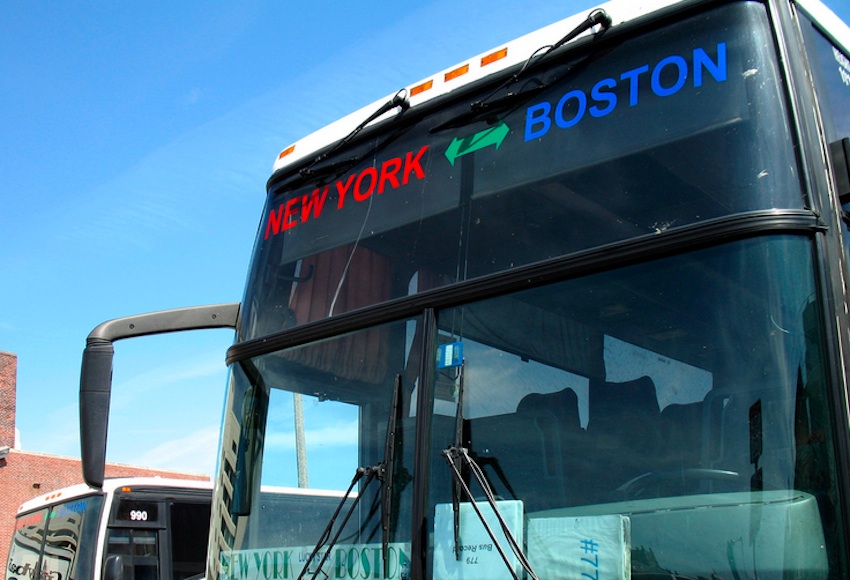How Unsafe Is the Commercial Bus Industry?

Lucky Star photo by antydiluvian on Flickr
The recent shut down of bus companies like Fung Wah, part of the federal government’s widespread crackdown on the commercial bus industry, prompts the question: are you actually less safe traveling by bus than other transit modes?
Through the years, prominent accidents have filled the evening news and made travel by Chinatown bus your mother’s worst nightmare. A Boston Globe investigation into the under-regulation of the bus industry seems to confirm your mother’s fears. The article notes that the government has started to demand more inspections and shut down more companies, but argues that it took much too long to do so. Why is there so much more safety regulation surrounding air travel when statistics suggest bus travel is “far more deadly” than the commercial airline industry? The Globe notes:
More than 170 people were killed in bus crashes from 2010 to early 2014, while no one died in commercial plane crashes on U.S. carriers during that period.
Comparing 170 deaths to zero deaths is a pretty stunning defeat for buses. But the U.S. motorcoach industry serves about 700 million people a year. Put in that context, how do buses compare to other forms of transit? In 2011, the website Politifact looked into it and found that the National Safety Council actually calculates the number of deaths per passenger mile traveled. Here’s how it broke down:
- Scheduled airlines: 0.003 deaths per 100 million passenger miles
- Commercial buses: 0.05 deaths per 100 million passenger miles
- Passenger trains: 0.06 deaths per 100 million passenger miles
- Automobiles, including taxis: 0.61 deaths per 100 million passenger miles
Airlines are indeed the safest mode of transit by this measure. But buses are slightly safer than trains, and far, far, far safer than cars, and in general, pretty safe. One person dies for every 2 billion miles Americans travel by bus.
Why does this matter? The Globe is criticizing the government for not doing enough to oversee the growing industry. The Federal Motor Carrier Safety Administration doesn’t appear to disagree. The regulator doesn’t have enough resources to meet the challenge, it argues. Federal dollars are a scarce quantity, and the story reads like the department’s case for why it should receive more of them.
On the other side are the small curbside carriers like Fung Wah. By offering dirt-cheap fares and convenient curbside pickups, these companies revolutionized the bus industry, forcing carriers like Greyhound to mimic the model. Now, the smaller companies frequently find themselves the targets of regulatory crackdown. An article in The Daily Beast last year argued that regulators actually didn’t help consumers by shutting down Chinatown buses:
The case of Lucky Star, a well-run company with a nearly spotless accident record, is the latest example of how the government’s stepped-up safety regime is destroying small bus companies to the benefit of large, politically-connected corporate carriers, and in the process making American travelers less safe.
The Globe’s investigation begs the question: Should we regulate buses like we do airlines? The heavily regulated airline industry is no doubt safer than the bus industry. But bus travel isn’t nearly as unsafe as car travel. And airline travel is also far more expensive. You might be slightly safer flying to New York than taking a BoltBus, but between getting to and from airports, accounting for security and baggage, etc., you won’t get there much faster, and you will pay more to do it. Since the federal government’s crackdown on companies that operate in Boston, it seems that prices are already rising. By offering a flat rate of $15 to New York, companies like Fung Wah forced price competition. BoltBus’s unicorn-like $1 fares, aside, try to show up to South Station and buy a same-day ticket to New York for $15. You can’t do it anymore.
The bus industry has produced some horror stories, and certainly even small companies should be forced to adhere to safety standards. But our desire for increased government oversight should come with an appropriate discussion of how much we risk when we step on a bus and how much we gain. Fiery bus crashes can loom large in the public consciousness, far larger than fiery car crashes. But for now, it helps to remember that the bus industry still remains an affordable safe alternative to car travel.


